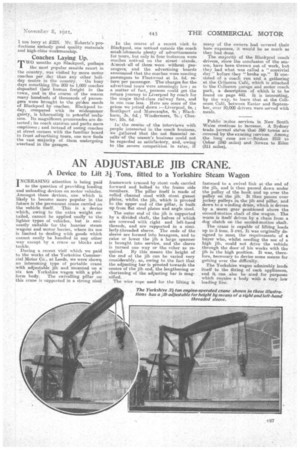AN ADJUSTABLE JIB CRANE.
Page 23

If you've noticed an error in this article please click here to report it so we can fix it.
ADevice to Lift 3i , Tons, fitted to a Yorkshire Steam Wagon
I NCREASING attention is being paid to the question of providing loading and unloading devices on motor vehicles. Amongst these devices, one which is likely to become more popular in the future is the permanent crane carried on the vehicle itself. This is a device which, owing to the extra weight entailed, cannot be applied easily to the lighter types of vehicles, but is eminently suitable for the heavier steam wagons and motor lorries, where its use is limited to dealing with goods which cannot easily be handled in any other way except by a crane or blocks and tackle.
• During a recent visit which we paid to the works of the Yorkshire Commer,cial Motor Co., at Leeds, we were shown an interesting type of portable crane with adjustable jib and mounted on a six ton Yorkshire wagon with a plat
form body. The swivelling pillar on this crane is supported in a strong steel framework trussed by stout rods carried forward and bolted to the frame side menlbers. The pillar itself is made of rolled channel steel with stout gusset plates, whilst the jib, which is pivoted to the upper end of the pillar, is built up from flat steel plates and angle steel.
The outer end of the jib is supported by a divided shaft, the halves of which are screwed with right and left-hand threads, and are supported in a similarly,threaded sleeve. The ends of the sleeve are formed into hexagons, and to raise or lower the jib a large spanner is brought into service, and the sleeve is turned one way or the other as required. By this means the height of the end of the jib can be varied very considerably, as, owing to the fact that the adjusting bar is pivoted towards the centre of the jib end, the lengthening or shortening of the adjusting bar is magnified.
The wire rope used for the lifting is fastened to a swivel link at the end of the jib, and is then passed down under the pulley of the hook and up over the pulley on the jib. It then passes over jockey pulleys in the jib and pillar, and down to a winding drum, which is driven by a worm gear positioned above the second-motion shaft of the wagon. The worm is itself driven by a chain from a dog clutch on the second-motion shaft.
The crane is capable of lifting loads up to 3 tons. 5 cwt. It was originally designed to meet the requirements of a buyer who, whilst needing the use of a high jib, could not drive the vehicle through the door of his works with the jib in the high position. It was, therefore, hecessary to devise some means for getting over the difficulty.
The Yorkshire wagon admirably lends itself to the fitting of such appliances, and it can also be used for purposes which require a body with a very low loading line.
































